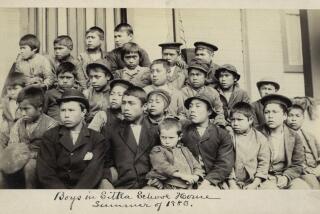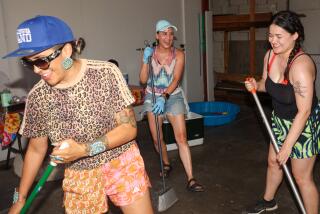Legends Are Living On in ‘Dreamkeeper’
ABC’s “Dreamkeeper” is that rarest of miniseries for which it is worth setting aside family viewing time.
Parents need not dread mind-numbing treacle for themselves or racy content for their children. The Hallmark Entertainment epic that airs Sunday and Monday pulls off the tricky feat of entertaining while educating viewers about Native American legends. Indeed, even the Native American stars say they learned much, especially about tribes other than their own.
“What always bothers me about the general knowledge of Native Americans is that the American public assumes there is one or two tribes,” says Delanna Studi, an actress of Cherokee, German and Irish descent who plays a Kiowa woman. “They are familiar with Sioux and Navajo. There are 547 federally recognized tribes.... Each tribe has its own language and culture and creation story. They weren’t just doing the major tribes everyone has heard of. Most people thought these had gone extinct. It keeps their people and their stories alive.”
Their stories and the way in which legends are passed through generations are the crux of the miniseries.
The ambitious story opens with Grandpa (August Schellenberg, “Black Robe”) telling stories to children on the reservation. He wants to go to an All Nations ceremony but is not well enough to drive alone from South Dakota to New Mexico. His disaffected grandson Shane (Eddie Spears, “Geronimo”), is coerced into driving him. This road trip gives the movie its framework, for as they drive Grandpa tells Shane stories.
“It was the role of a lifetime, and I have been doing this for 40 years,” Schellenberg says. “I knew a few people like him,” he says of the aged storyteller. Schellenberg, who is Mohawk and Swiss, grew up in Montreal in a foster home. He learned some Lakota for the part and was thrilled when he realized the scope of this project.
“After the first day, I came home and said this man [director Steve Barron] is not making television, he is making a movie,” Schellenberg says. “For an actor, that is such a treat nowadays. So many directors just wing it.... Everything was in the [Canadian] province of Alberta. It was wonderful. We had snow when we needed it and rain when we needed it. The spirits were with us.”
Spirits and spirituality are central to the legends. In the first, “Legend of Eagle Boy’s Vision Quest,” a young man fasts and meditates for days, seeking guidance. He learns that the goodness of the Earth, of people and of spirits must work together.
It took 2,500 Native Americans, from extras to advisors, to make the 10 stories come alive. Each story does, from 1,500 buffaloes stampeding across an Alberta plain to the special effects of “Legend of She Crosses the Water and the Thunder Spirit.”
In this one, the powerful thunder spirit falls in love with a Mohawk woman working in a cornfield. He persuades her to come to his realm, but when she becomes pregnant, she returns to her people. The only caveat is that no one must ever strike their son, and when his mortal grandmother slaps the rambunctious boy, he is taken to the sky.
No narrator drills in the moral of each story, though lessons abound.
Shot over four months, primarily in Canada, each legend has its own actors and individual look. The movie employed 15 Native American and Native Canadian advisors to ensure the authenticity of every detail.
In one tale, “Legend of Quillwork Girl and Her Seven Star Brothers,” even the advisor was shocked to see rare Cheyenne leopard dogs. When men were hanging buffalo meat in the background, the advisor said women would have done that chore, so Barron changed the scene.
“Dreamkeeper” tackles tough subjects, such as that of a white boy reared by Kiowas in “Legend of Tehan, the Red-Haired, White Kiowa.” He is not fully accepted by either group, but his Kiowa sister, Talks A Lot (Studi), stands by him.
Not all of the legends are serious. “Legend of Coyote and Iktome” and “Legend of Coyote and Iktome and Iktome’s Wife” are slapstick.
These legends are Spears’ favorites. Playing a troubled teen who owes money to gangbangers and listens to rap was great, he says. “I kind of relate to him, growing up on ‘the res,’ ” says Spears, a Lakota who spent his first six years on a reservation before moving to Pierre, S.D.
The actors rave about the miniseries’ accuracy, which offers the sort of detailed history that is usually the purview of drier documentaries. Given that “Dreamkeeper” is told as a series of stories, viewers will probably stick with it, and by doing so learn more about indigenous people.
Studi, a niece of actor Wes Studi, says she hopes viewers glean “the fact that Native Americans are a living people, a modern people, and we have such complex and interesting stories. We are not all the same.”
Studi, comic Alan Sues’ personal assistant in Los Angeles, says: “I am hoping it will develop a new respect for us. And my main hope for the native viewers is I want people like my father, who was sent to boarding school to have the Indian beaten out him, I want them to be proud again. I want the youth to learn as much as possible.
“A lot of our elders are passing, and when they pass, people like myself and like my little sister will need to keep the stories alive. I am hoping that the native youth will embrace this, so people will always know we are still here.”
Jacqueline Cutler writes for Tribune Media Services.
“Dreamkeeper” airs at 9 p.m. Sunday and Monday on ABC. The network has rated Part 1 as TV-PG-LV (may be unsuitable for young children, with advisories for coarse language and violence). Part 2 is rated TV-14 (may be unsuitable for children younger than 14).
Cover photograph by Bob D’Amico.
More to Read
The complete guide to home viewing
Get Screen Gab for everything about the TV shows and streaming movies everyone’s talking about.
You may occasionally receive promotional content from the Los Angeles Times.






